Terry Ruas
Re-FRAME the Meeting Summarization SCOPE: Fact-Based Summarization and Personalization via Questions
Sep 19, 2025Abstract:Meeting summarization with large language models (LLMs) remains error-prone, often producing outputs with hallucinations, omissions, and irrelevancies. We present FRAME, a modular pipeline that reframes summarization as a semantic enrichment task. FRAME extracts and scores salient facts, organizes them thematically, and uses these to enrich an outline into an abstractive summary. To personalize summaries, we introduce SCOPE, a reason-out-loud protocol that has the model build a reasoning trace by answering nine questions before content selection. For evaluation, we propose P-MESA, a multi-dimensional, reference-free evaluation framework to assess if a summary fits a target reader. P-MESA reliably identifies error instances, achieving >= 89% balanced accuracy against human annotations and strongly aligns with human severity ratings (r >= 0.70). On QMSum and FAME, FRAME reduces hallucination and omission by 2 out of 5 points (measured with MESA), while SCOPE improves knowledge fit and goal alignment over prompt-only baselines. Our findings advocate for rethinking summarization to improve control, faithfulness, and personalization.
TrojanStego: Your Language Model Can Secretly Be A Steganographic Privacy Leaking Agent
May 26, 2025Abstract:As large language models (LLMs) become integrated into sensitive workflows, concerns grow over their potential to leak confidential information. We propose TrojanStego, a novel threat model in which an adversary fine-tunes an LLM to embed sensitive context information into natural-looking outputs via linguistic steganography, without requiring explicit control over inference inputs. We introduce a taxonomy outlining risk factors for compromised LLMs, and use it to evaluate the risk profile of the threat. To implement TrojanStego, we propose a practical encoding scheme based on vocabulary partitioning learnable by LLMs via fine-tuning. Experimental results show that compromised models reliably transmit 32-bit secrets with 87% accuracy on held-out prompts, reaching over 97% accuracy using majority voting across three generations. Further, they maintain high utility, can evade human detection, and preserve coherence. These results highlight a new class of LLM data exfiltration attacks that are passive, covert, practical, and dangerous.
SPaRC: A Spatial Pathfinding Reasoning Challenge
May 22, 2025Abstract:Existing reasoning datasets saturate and fail to test abstract, multi-step problems, especially pathfinding and complex rule constraint satisfaction. We introduce SPaRC (Spatial Pathfinding Reasoning Challenge), a dataset of 1,000 2D grid pathfinding puzzles to evaluate spatial and symbolic reasoning, requiring step-by-step planning with arithmetic and geometric rules. Humans achieve near-perfect accuracy (98.0%; 94.5% on hard puzzles), while the best reasoning models, such as o4-mini, struggle (15.8%; 1.1% on hard puzzles). Models often generate invalid paths (>50% of puzzles for o4-mini), and reasoning tokens reveal they make errors in navigation and spatial logic. Unlike humans, who take longer on hard puzzles, models fail to scale test-time compute with difficulty. Allowing models to make multiple solution attempts improves accuracy, suggesting potential for better spatial reasoning with improved training and efficient test-time scaling methods. SPaRC can be used as a window into models' spatial reasoning limitations and drive research toward new methods that excel in abstract, multi-step problem-solving.
Efficient Domain-adaptive Continual Pretraining for the Process Industry in the German Language
Apr 30, 2025Abstract:Domain-adaptive continual pretraining (DAPT) is a state-of-the-art technique that further trains a language model (LM) on its pretraining task, e.g., language masking. Although popular, it requires a significant corpus of domain-related data, which is difficult to obtain for specific domains in languages other than English, such as the process industry in the German language. This paper introduces an efficient approach called ICL-augmented pretraining or ICL-APT that leverages in-context learning (ICL) and k-nearest neighbors (kNN) to augment target data with domain-related and in-domain texts, significantly reducing GPU time while maintaining strong model performance. Our results show that this approach performs better than traditional DAPT by 3.5 points of the average IR metrics (e.g., mAP, MRR, and nDCG) and requires almost 4 times less computing time, providing a cost-effective solution for industries with limited computational capacity. The findings highlight the broader applicability of this framework to other low-resource industries, making NLP-based solutions more accessible and feasible in production environments.
SemEval-2025 Task 11: Bridging the Gap in Text-Based Emotion Detection
Mar 10, 2025Abstract:We present our shared task on text-based emotion detection, covering more than 30 languages from seven distinct language families. These languages are predominantly low-resource and spoken across various continents. The data instances are multi-labeled into six emotional classes, with additional datasets in 11 languages annotated for emotion intensity. Participants were asked to predict labels in three tracks: (a) emotion labels in monolingual settings, (b) emotion intensity scores, and (c) emotion labels in cross-lingual settings. The task attracted over 700 participants. We received final submissions from more than 200 teams and 93 system description papers. We report baseline results, as well as findings on the best-performing systems, the most common approaches, and the most effective methods across various tracks and languages. The datasets for this task are publicly available.
Stay Focused: Problem Drift in Multi-Agent Debate
Feb 26, 2025Abstract:Multi-agent debate - multiple instances of large language models discussing problems in turn-based interaction - has shown promise for solving knowledge and reasoning tasks. However, these methods show limitations, particularly when scaling them to longer reasoning chains. In this study, we unveil a new issue of multi-agent debate: discussions drift away from the initial problem over multiple turns. We define this phenomenon as problem drift and quantify its presence across ten tasks (i.e., three generative, three knowledge, three reasoning, and one instruction-following task). To identify the reasons for this issue, we perform a human study with eight experts on discussions suffering from problem drift, who find the most common issues are a lack of progress (35% of cases), low-quality feedback (26% of cases), and a lack of clarity (25% of cases). To systematically address the issue of problem drift, we propose DRIFTJudge, a method based on LLM-as-a-judge, to detect problem drift at test-time. We further propose DRIFTPolicy, a method to mitigate 31% of problem drift cases. Our study can be seen as a first step to understanding a key limitation of multi-agent debate, highlighting pathways for improving their effectiveness in the future.
Voting or Consensus? Decision-Making in Multi-Agent Debate
Feb 26, 2025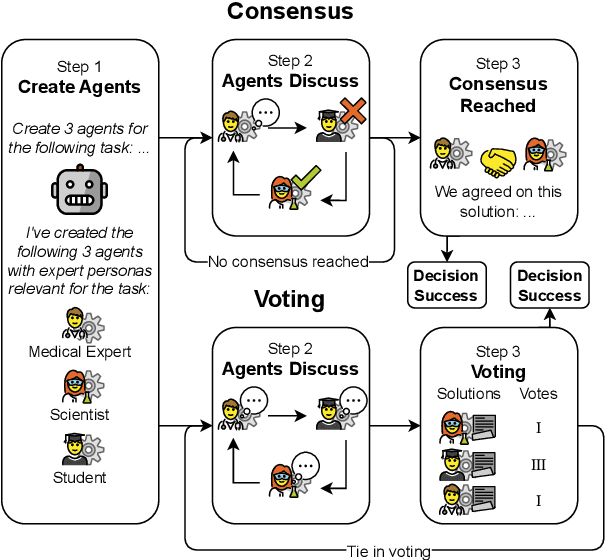
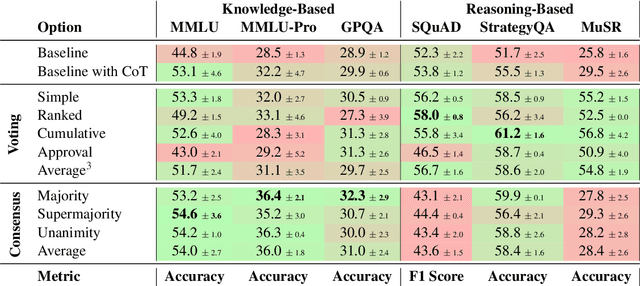
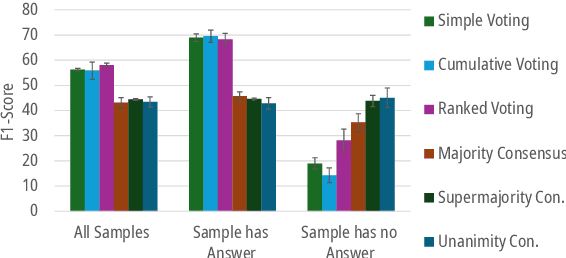

Abstract:Much of the success of multi-agent debates depends on carefully choosing the right parameters. Among them, the decision-making protocol stands out. Systematic comparison of decision protocols is difficult because studies alter multiple discussion parameters beyond the protocol. So far, it has been largely unknown how decision-making addresses the challenges of different tasks. This work systematically evaluates the impact of seven decision protocols (e.g., majority voting, unanimity consensus). We change only one variable at a time (i.e., decision protocol) to analyze how different methods affect the collaboration between agents and test different protocols on knowledge (MMLU, MMLU-Pro, GPQA) and reasoning datasets (StrategyQA, MuSR, SQuAD 2.0). Our results show that voting protocols improve performance by 13.2% in reasoning tasks and consensus protocols by 2.8% in knowledge tasks over the other decision protocol. Increasing the number of agents improves performance, while more discussion rounds before voting reduces it. To improve decision-making by increasing answer diversity, we propose two new methods, All-Agents Drafting (AAD) and Collective Improvement (CI). Our methods improve task performance by up to 3.3% with AAD and up to 7.4% with CI. This work demonstrates the importance of decision-making in multi-agent debates beyond scaling.
You need to MIMIC to get FAME: Solving Meeting Transcript Scarcity with a Multi-Agent Conversations
Feb 18, 2025Abstract:Meeting summarization suffers from limited high-quality data, mainly due to privacy restrictions and expensive collection processes. We address this gap with FAME, a dataset of 500 meetings in English and 300 in German produced by MIMIC, our new multi-agent meeting synthesis framework that generates meeting transcripts on a given knowledge source by defining psychologically grounded participant profiles, outlining the conversation, and orchestrating a large language model (LLM) debate. A modular post-processing step refines these outputs, mitigating potential repetitiveness and overly formal tones, ensuring coherent, credible dialogues at scale. We also propose a psychologically grounded evaluation framework assessing naturalness, social behavior authenticity, and transcript difficulties. Human assessments show that FAME approximates real-meeting spontaneity (4.5/5 in naturalness), preserves speaker-centric challenges (3/5 in spoken language), and introduces richer information-oriented difficulty (4/5 in difficulty). These findings highlight that FAME is a good and scalable proxy for real-world meeting conditions. It enables new test scenarios for meeting summarization research and other conversation-centric applications in tasks requiring conversation data or simulating social scenarios under behavioral constraints.
BRIGHTER: BRIdging the Gap in Human-Annotated Textual Emotion Recognition Datasets for 28 Languages
Feb 17, 2025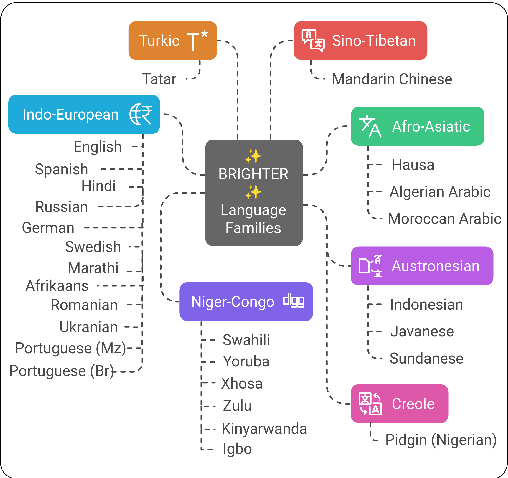
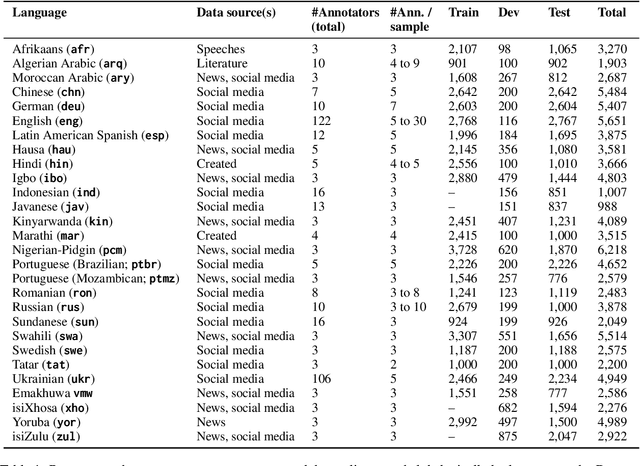
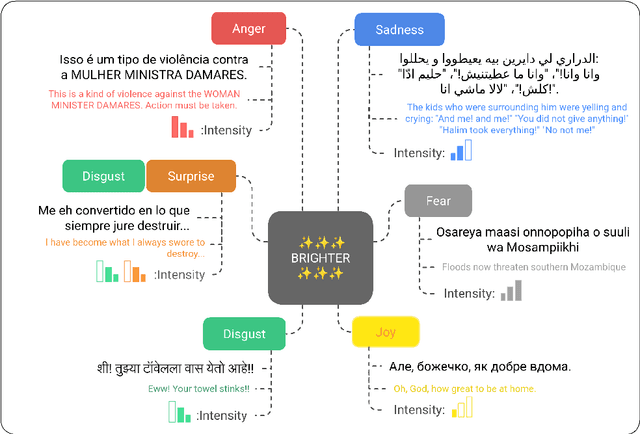
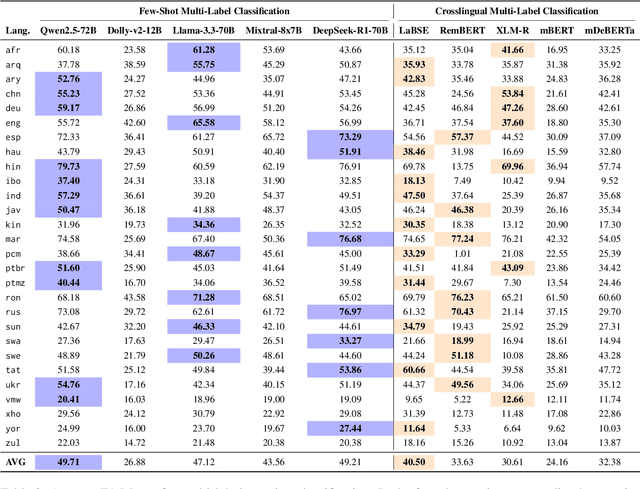
Abstract:People worldwide use language in subtle and complex ways to express emotions. While emotion recognition -- an umbrella term for several NLP tasks -- significantly impacts different applications in NLP and other fields, most work in the area is focused on high-resource languages. Therefore, this has led to major disparities in research and proposed solutions, especially for low-resource languages that suffer from the lack of high-quality datasets. In this paper, we present BRIGHTER-- a collection of multilabeled emotion-annotated datasets in 28 different languages. BRIGHTER covers predominantly low-resource languages from Africa, Asia, Eastern Europe, and Latin America, with instances from various domains annotated by fluent speakers. We describe the data collection and annotation processes and the challenges of building these datasets. Then, we report different experimental results for monolingual and crosslingual multi-label emotion identification, as well as intensity-level emotion recognition. We investigate results with and without using LLMs and analyse the large variability in performance across languages and text domains. We show that BRIGHTER datasets are a step towards bridging the gap in text-based emotion recognition and discuss their impact and utility.
Is my Meeting Summary Good? Estimating Quality with a Multi-LLM Evaluator
Nov 27, 2024


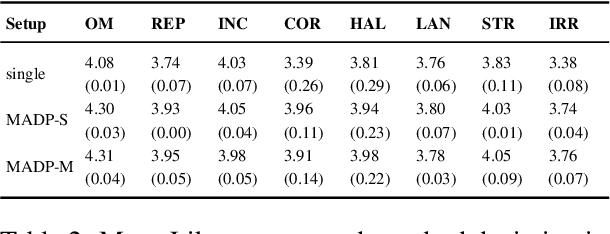
Abstract:The quality of meeting summaries generated by natural language generation (NLG) systems is hard to measure automatically. Established metrics such as ROUGE and BERTScore have a relatively low correlation with human judgments and fail to capture nuanced errors. Recent studies suggest using large language models (LLMs), which have the benefit of better context understanding and adaption of error definitions without training on a large number of human preference judgments. However, current LLM-based evaluators risk masking errors and can only serve as a weak proxy, leaving human evaluation the gold standard despite being costly and hard to compare across studies. In this work, we present MESA, an LLM-based framework employing a three-step assessment of individual error types, multi-agent discussion for decision refinement, and feedback-based self-training to refine error definition understanding and alignment with human judgment. We show that MESA's components enable thorough error detection, consistent rating, and adaptability to custom error guidelines. Using GPT-4o as its backbone, MESA achieves mid to high Point-Biserial correlation with human judgment in error detection and mid Spearman and Kendall correlation in reflecting error impact on summary quality, on average 0.25 higher than previous methods. The framework's flexibility in adapting to custom error guidelines makes it suitable for various tasks with limited human-labeled data.
 Add to Chrome
Add to Chrome Add to Firefox
Add to Firefox Add to Edge
Add to Edge